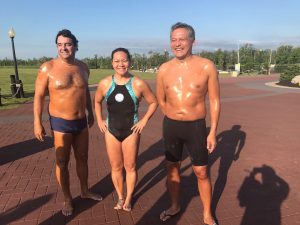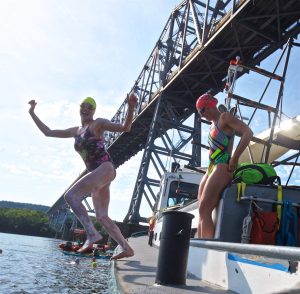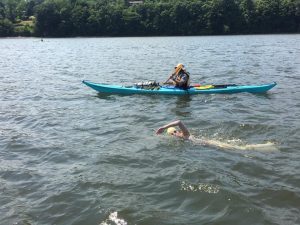This is the last thing I’ll say about this for now: here is my story. I set out on an adventure last week. I swam a lot, learned a lot, laughed a lot, and in the end accomplished what I set out to do. There is much to tell. Some of it I’ll write now, some of it I’ll tell you in person, and some of it you’ll never hear.
Stage 1
I said that I wouldn’t race, told myself for months to pace. But that tail wind pushing us downriver felt so nice. There aren’t many distractions up north and I was feeling strong. Having Rondi and John pacing next to me made me feel stronger. They were my training companions two years ago, so it felt like old times trying to keep up with them, pushing myself to match their speed.
Stage 2
Somewhere around the five hour mark, my kayaker Darian is told by Launch 5 captain Greg that if I swim the next 2.5 miles in 25 minutes, I’ll have Grace’s record. An audible laugh was my first response, but then I remember the current and some mental math I’d been doing earlier. If I swam fast, that might work! So I swam fast. At the bridge, out of breath, I’m told I got the record. The men’s record, they mean. I was 25 minutes behind Grace’s. That is when I learn that Greg may not be a reliable source for when to sprint. No more record chasing for me. Greg’s comment becomes a great source of entertainment for me for the remainder of the week.
After I finish, we spot Penrose fighting the flood tide along the Poughkeepsie waterfront. The current is against him, but he’s still going for it, sneaking along shore in front of us. I want a closer look, so put my suit back on and tell Harris to get off the paddle board. Watching James finish his swim from right alongside is great. My arms ache as I paddle back to the dock.
Stage 3
The snooze button gets hit again because I’m feeling too nauseous to sit up. Food will fix it, I think, but it doesn’t. Driving to the train station, I’m doing my best to avoid defiling my father’s steering wheel. He’s turned the air off in the car, I snap at him, turn it back on, and the sick feeling recedes. On the train, my sandals break.
My stomach feels no better swimming. My feeds go down and come right back up. My mouth feels dry despite both the amount of water I’m drinking and the fact that I’m swimming in water. It feels like my stomach has shut down, nothing is passing through. And strangely, I’m cold. I shouldn’t be cold.
We stop at the New Hamburgh Yacht Club, slightly off course, to chat briefly with Marylou, Ken, and Diane. It has been years since I’ve seen them. Treading against the current off the end of the dock, I see Rufus at the top of the ramp. He’s whimpering. Rufus always got nervous when I swam there. He used to doggie paddle out behind me when I left shore, and then turn back when I got too far.
Dave paddles over and asks how I’m doing. Something isn’t right, I tell him, but whatever it is, the answer is just there on the other side of that bridge.
Stage 4
The scenery is gorgeous. This is the closest I’ve come to Bannerman’s Island. Seeing Breakneck and Storm King loom up ahead is awesome. Watching them fly by is better. I made the rookie mistake of getting sunscreen in my goggles, so I stop often to take them off and enjoy my surroundings.
Somewhere in those surroundings I find my friend Emily. She is waiting on Little Stony Point. Emily is the one who put me in touch with Darian. She’s come up from the Upper East Side with Nick to watch us go by. We exchange a few words, but don’t stay long.
Stage 5
We pass Indian Point and the water gets predictably warmer. It also feels smoother somehow, and the waves are less irritating. I find a rhythm and pick up my pace. Rondi is up ahead pacing the lead swimmer. I steal her as I pass by, I’m now the lead swimmer. I seem to have found my power in the cooling water of a nuclear power plant.
We pass another power plant, this one far off on the west shore. It marks the halfway point, so I mentally await the symbolic moment when I’m directly in front of it. Watching the smokestacks move in front of the buildings behind takes ages. I’ll never reach halfway.
John jumps in tells me he has bad news. I’ll have to kick, he says, the tide might be turning soon. We pound our way into the waves together. His motions make him look like a porpoise, I think to myself. He tells me a little later that Rondi says once we reach the lighthouse we only have fifteen minutes farther to swim. The lighthouse approaches very slowly.
An hour or so later, I’m still between the lighthouse and the bridge. I’ve been lying to myself for an unknown period of time, only fifteen more, thirty more minutes. I look at the bridge. I’m ready to be done with this. Sure, I want to be under the bridge, but I want to be done. I look up again, and the bridge is a hair closer. If it were farther, if I were moving backwards, I would be done. But it isn’t, so I keep swimming.
The bridge doesn’t grow, but I can tell by the positions of the stanchions when I breathe that I’m still making progresss. Let’s end this, is the nicest thing I’ve said to the bridge for hours. That bridge is one of the few things to ever see me get angry. I sprint the last few hundred yards and it takes ages. I’ve been sprinting since the lighthouse.
7:30, I think when I get on the boat. Any longer and the tide would have changed I’d never have made it. 9:22, Rondi tells me. No way. I check the time of day. No way. I check the position of the sun. Finally it sinks in, the current has been flooding for nearly two hours, but I never admitted it to myself. Where did the time go?
Stage 6
Oh, this again? and I stop after ten strokes. The waves feel exactly like they did a few hours ago when I arrived at this bridge. I put my face back in and swim because I want to leave put the Tappan Zee far behind me. That bridge and I aren’t friends.
The scenery becomes familiar again. I watch the Palisades slide by on one side, and the Yonkers and Bronx rise on the other. Then there is the Henry Hudson Bridge over Spuyten Duyvil. I count down the blocks and watch the GW grow ahead.
Stage 7
The last time I swam this whole stretch of river she was next to me, and she’s here again. Christina paddles to my left, Darian to my right. She’s been kayaking for swimmers exactly as long as I have been swimming for kayakers, Christina was there when I first swam in the Hudson. I’m glad she’s here today, for many reasons.
Counting down the cross streets. Suddenly we’re at North Cove, the end of MIMS. Then we’re past it. I look up and hear a bell. I stop. There’s a green bell buoy ringing its carillon behind me, a packed Liberty Island ferry up ahead, and Statue off to my right. Caitlin has made her way into our company on board a small RIB. It feels fitting that she is here too.
With every breath I see a new tug and barge, or large ferry, or freighter. This harbor is busy. The Narrows Bridge is playing along with our little game. It is getting bigger, just like it is supposed to. We’re heading into waves two to three feet high, but I don’t care. The bridge is getting bigger!
Ed told me earlier in the week that the best moment in the swim is when you can see the bridge up ahead just by turning to the side to breathe. I can do that now. We’re close. Jumping in that morning was the most nervous I’d been on during this adventure; so close, but still with six hours of swimming to go. But now there’s nothing in my way now. Not storms, nor injury, nor boats, nor current. There’s nothing stopping me.



